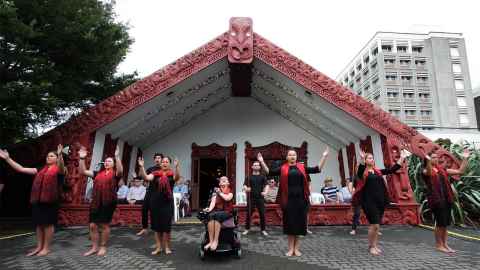What is a Pōwhiri?
A pōwhiri is a traditional ceremony welcoming people onto a marae.
What to expect
In this case the pōwhiri is an official welcome for all new students to the University of Auckland. It removes the tapu (restrictions) of the manuhiri (visitors) to make them one with the tangata whenua (hosts). Protocols differ from marae to marae.
Pōwhiri are held at Waipapa Marae or Te Aka Matua o te Pou Hawaiki Marae (Faculty of Education and Social Work). When you arrive, you will spot the UniCrew in navy coloured t-shirts. The ambassadors are there to help guide you and prepare you for the processes prior to being welcomed on to the marae.
Pōwhiri procedure
- Groups will select a kaikaranga (an adult female) able to return the welcoming call from tangata whenua/host and one or two kaikōrero (adult male speakers) to respond to the kaikōrero tangata whenua/host speeches of welcome.
- The group gathers together closely at the waharoa which is the gateway to the marae ātea (forecourt between the waharoa and the wharenui/carved house).
- The karanga (welcoming call) from tangata whenua is given. This acknowledges the arrival of manuhiri and invites manuhiri to move respectfully onto the marae. It is usually led by the kaikaranga followed by women and children, in turn followed by the men, i.e. men should position themselves at the back and to the sides of the women.
- Visitors will stop an appropriate distance in front of the carved house and a minute’s silence will be observed (bowing our heads) to remember our loved ones - both tangata whenua and manuhiri - that have passed on.The karanga also acknowledges the kaupapa (purpose) for their visit, who the visitors are, and, if known, where they are from.
- Finally the karanga accepts the manuhiri and once manuhiri have reached their seats, they should remain standing until the kaikōrero tangata whenua indicates that they may sit.
Order of speeches
- First a waiata/song is to be sung by the host; manuhiri/visitors also are asked to sing the waiata if they know the words.
- A karakia/blessing is then recited.
- The tikanga is pāeke (all local speakers will speak first). Manuhiri are then offered the right of reply, which on a marae should be in Māori in the first instance.
- All speeches are followed by a waiata tautoko/song of support.
- Men only are to sit in the front row of seats provided.
- The last speaker is to sit on the chair closest to the carved house. Therefore the person seated on his left is to speak first.
- If there is a koha it is to be laid down by the last speaker for the manuhiri followed by a waiata. This will then be picked up and acknowledged by the tangata whenua.
- Tangata whenua will then complete the process and invite manuhiri to move across to harirū/shake hands and hongi/press noses with tangata whenua/hosts.
- This is followed by partaking in kai/food.

Speaking on the marae
If you are comfortable speaking te reo Māori or any language other than English, you might want to consider being a kaikōrero (speaker on behalf of the students)/kaiwhakahoki i te karanga (responder to the karanga). If you do wish to speak, please let one of the UniCrew know well in advance.
Appropriate behaviour
- Please ensure all mobile phones are turned off, nobody is eating and everyone is respectfully listening to all that is occurring during the procedure of the pōwhiri.
- We ask that manuhiri respect a tidy dress code. Absolutely no sports shorts, singlets or unpresentable dress attire.
- If you are late, do not walk onto the marae or into the carved house. That would be disrespectful.